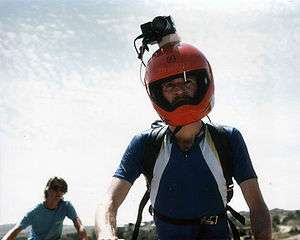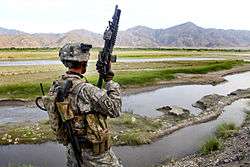Body camera
Body worn video (BWV), also known as body cameras and body-worn cameras, or wearable cameras is a wearable audio, video, or photographic recording system.


.jpg)
Body worn video has a range of uses and designs, of which the best-known use is as a part of policing equipment. Other uses include action cameras for social and recreational (including cycling), within commerce, in healthcare and medical use, in military use, journalism, citizen sousveillance and covert surveillance.
Nascent research on the impact of body-worn cameras in law enforcement shows mixed evidence as to the impact of cameras on the use of force by law enforcement and communities' trust in police.[1]
Designs
Body worn cameras are often designed to be worn in one of three locations: on the torso, on or built into a helmet, and on or built into glasses. Some feature live streaming capabilities while others are based on local storage. The National Criminal Justice Technology Research, Test, and Evaluation Center has conducted market surveys on the body worn cameras to assist organisations in purchasing the best camera. The survey discusses device functionality, optics, audio, GPS, and several more categories. These cameras range in price from 200 dollars to 2,000 dollars.[2]
Applications
Law enforcement
Wearable cameras are used by police and other law enforcement organizations in countries around the world. The cameras are intended to improve interactions between officers and the public. The first generation of 'modern' police body cameras was introduced around 2005 in the United Kingdom, followed from 2014 onwards by large scale implementation in the United States, mainly to increase transparency and police accountability. Other countries have followed the trend. Early studies overwhelmingly showed positive results, but replications have led to mixed findings. Outcomes have been shown to differ depending on the local context and the guidelines regulating activation of the bodycams. Challenges include training, privacy, storage and the use of recordings further 'downstream' in the judicial system.
Military combat

Body worn cameras, as well as helmet cameras are used in the military.[3]. Video can either be stored locally, or streamed back to a command center or military outpost. A notable instance of this was the raid on Osama Bin Laden’s compound, where live video footage of the raid is believed to have been streamed to the White House.[4] In 2013, a British Royal Marine soldier was convicted of murder after shooting to death an unarmed and injured Afghan insurgent, contrary to the Geneva Convention. The incident had been recorded by a helmet camera whose images and sound were used in evidence at a court martial relating to the incident.[5] The helmet camera has been the focus of the Discovery Channel series Taking Fire about the 101st Airborne in the Korengal documenting their personal war footage. In 2016 "a camera recovered from the helmet of a dead fighter offers a contrasting picture of chaos and panic in a battle with Kurdish peshmerga."[6]
Firefight
.jpg)
Firefighters use helmet cameras as a tool to assess fires and for communication and training purposes. Cameras in this occupation are often thermal cameras in order to be able to see in darkness and inside smoke-filled buildings. Augmented reality can be added to accentuate outlines of objects and people.[7]
Healthcare
Body worn video has been suggested and explored in parts of the medical field. Data recorded from wearable cameras can assist in medical research and limit error caused by inaccurate self-reporting of data.[8] It is speculated that under-reporting is common when conducting dietary and nutrition assessments.[9] Research suggests body worn video reduces under-reporting of intake during such assessments.[10] Cameras can for example be used as a memory prosthetic for conditions that affect the memory.[11] Body worn devices have been used to assist in clinical settings. In 2013, Google Glass was used to assist in surgery by providing a mostly hands-free way to broadcast and receive consultation from another surgeon.[12] Body cameras were provided to hospital staff by the Cardiff and Vale Health Board in Wales, United Kingdom. The cameras were issued to reduce the likelihood of violent assaults against staff. According to the manager who provides support to staff who have been attacked, the cameras – and especially the audio recording – have been vital for successful prosecutions.[13]
Privacy concerns
Concerns over privacy have been raised with this technology, most notably in the context of Google Glasses and policing. The advent of large-scale data collection, possibly in combination with facial recognition and other technologies capable of interpreting videos in bulk, means that all cameras, including body worn cameras, could create a means of tracking people anywhere they go. In policing, critics have warned that each police officer could become a "roving surveillance camera"[14] Police will interact with citizens during vulnerable moments,[15] such as in a hospital, or in a domestic violence situation. Concerns have also been raised that this algorithms not only infringe on privacy rights, but could also be ethnically biased.[16] The American Civil Liberties Union has suggested policies to balance citizen's rights with the desire for more transparency and accountability.[17]
References
- "Do Police Body-Worn Cameras Reduce the Use of Force? | Econofact". Econofact. 2017-11-17. Retrieved 2017-11-18.
- Hung, Vivian; Babin, Steven (2016). "A Market Survey on Body Worn Camera Technologies" (PDF). Laurel, Maryland: Johns Hopkins University Applied Physics Laboratory. Retrieved 5 March 2017.
- Bud, T. K. (2016). The Rise and Risks of Police Body-Worn Cameras in Canada. Surveillance & Society, 14(1), 117–121.
- "Obama watched live video of bin Laden raid, U.S. official says". CNN. May 20, 2011.
- "Royal Marine guilty of murder". BBC News. November 8, 2013.
- Reuters, "Helmet cam footage shows Islamic State in chaos," April 29, 2016 https://www.reuters.com/article/us-mideast-crisis-iraq-idUSKCN0XQ134
- News, CBS (31 December 2018). "New augmented reality technology could help firefighters save lives". www.cbsnews.com. Retrieved 2019-05-08.
- Doherty, Aiden R.; Hodges, Steve E.; King, Abby C.; Smeaton, Alan F.; Berry, Emma; Moulin, Chris J.A.; Lindley, Siân; Kelly, Paul; Foster, Charlie (March 2013). "Wearable Cameras in Health". American Journal of Preventive Medicine. 44 (3): 320–323. doi:10.1016/j.amepre.2012.11.008. ISSN 0749-3797. PMID 23415132.
- Pettitt, Claire; Liu, Jindong; Kwasnicki, Richard M.; Yang, Guang-Zhong; Preston, Thomas; Frost, Gary (2016-01-14). "A pilot study to determine whether using a lightweight, wearable micro-camera improves dietary assessment accuracy and offers information on macronutrients and eating rate". The British Journal of Nutrition. 115 (1): 160–167. doi:10.1017/S0007114515004262. hdl:10044/1/26551. ISSN 1475-2662. PMID 26537614.
- Gemming, Luke; Rush, Elaine; Maddison, Ralph; Doherty, Aiden; Gant, Nicholas; Utter, Jennifer; Ni Mhurchu, Cliona (2015-01-28). "Wearable cameras can reduce dietary under-reporting: doubly labelled water validation of a camera-assisted 24 h recall". The British Journal of Nutrition. 113 (2): 284–291. doi:10.1017/S0007114514003602. ISSN 1475-2662. PMID 25430667.
- Visual Memory Prosthetic, 1996
- Schreinemacher, Marc H.; Graafland, Maurits; Schijven, Marlies P. (2014-11-11). "Google Glass in Surgery". Surgical Innovation. 21 (6): 651–652. doi:10.1177/1553350614546006. ISSN 1553-3506. PMID 25389144.
- Seal, Chris (17 February 2015). "Body cameras for hospital security staff to clamp down on violence". Barry And District News. Retrieved 2019-05-07.
- Tilley, Aaron. "Artificial Intelligence Is Coming To Police Bodycams, Raising Privacy Concerns". Forbes. Retrieved 2017-03-03.
- "Police Perspective: The Pros & Cons of Police Body Cameras". www.rasmussen.edu. Retrieved 2017-04-16.
- "How Police Body Cameras Work". HowStuffWorks. 2015-06-12. Retrieved 2017-03-03.
- "A Model Act for Regulating the Use of Wearable Body Cameras by Law Enforcement". American Civil Liberties Union. June 2018. Retrieved 2019-05-08.
External links
| Wikimedia Commons has media related to Body worn video. |
- Tanner S., Meyer M., Police work and new 'security devices' : a tale from the beat. Security Dialogue, 46 (4), 2015: 384–400.
- Police Body Cameras: What Do You See?. The New York Times.